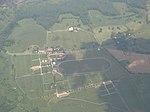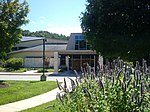Worthington Valley Historic District
Baltimore County, Maryland Registered Historic Place stubsGreek Revival architecture in MarylandHistoric districts in Baltimore County, MarylandHistoric districts on the National Register of Historic Places in MarylandNRHP infobox with nocat ... and 3 more
National Register of Historic Places in Baltimore County, MarylandNeoclassical architecture in MarylandReisterstown, Maryland

Worthington Valley Historic District is a national historic district in Reisterstown, Baltimore County, Maryland, United States. It is a largely rural district where the earliest standing structures date from the very end of the 18th century. Horse breeding and racing is a very large and lucrative business in the valley. Since 1922, Snow Hill and Worthington Farms have been the scene of the Maryland Hunt Cup Steeplechase. Located next to it is the Western Run–Belfast Road Historic District. It was added to the National Register of Historic Places in 1976.
Excerpt from the Wikipedia article Worthington Valley Historic District (License: CC BY-SA 3.0, Authors, Images).Worthington Valley Historic District
Tufton Avenue,
Geographical coordinates (GPS) Address Nearby Places Show on map
Geographical coordinates (GPS)
| Latitude | Longitude |
|---|---|
| N 39.499722222222 ° | E -76.755277777778 ° |
Address
Tufton Avenue
21071
Maryland, United States
Open on Google Maps







